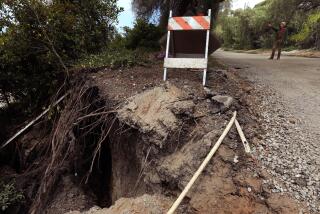Whale of an Old Specimen : Paleontology: A 4-million-year-old skeleton is being hailed as the best preserved and most complete of its kind.
From its 6-foot jaw to its wrist bones, a 4-million-year-old whale skeleton unearthed on a hillside here is being hailed as the most complete, well-preserved specimen of its kind ever discovered, excited paleontologists said Tuesday.
“This is probably the best whale skeleton ever found. Ever, anywhere, period,” said Steve Conkling, a paleontologist who works for the county. “There are things preserved on this specimen I’ve never seen preserved even on modern whales.”
Everything on this 24-foot, toothless baleen whale is intact, from the vertebrae to the pelvic girdle, a set of four bones that float freely inside the skeleton and act as the whale’s pelvis.
“Those are usually swept away at some point after the whale dies,” said John Minch, a paleontologist on sabbatical from Saddleback College who actually found the specimen in the path of the San Joaquin Hills Transportation Corridor. After a week of painstaking work, the skeleton was unearthed Monday.
“We find them, but not actually in place. Everything on this thing is right here,” Minch said.
And unlike many whale skeletons that remain stored in warehouses for years, this specimen will be picked up in three pieces and moved to the county’s Ralph B. Clark Park in Buena Park, where it will be on display by late summer.
“That’s one of the things we are excited about. It will go directly from the field to display,” said Minch, who also is the chairman of the Orange County Natural History Assn. “People will actually be able to see it. It’s only missing one flipper, which was cut off by the scraper.”
Minch and his assistants have found nine whale skeletons within 100 yards of each other on the hillside just off Crown Valley Parkway, but nothing as complete as this one. The skeleton was on its back, the normal position for dying whales, which tend to bloat with gas and roll over before they eventually sink to the bottom, Minch said.
“This one must have died a very quiet death,” Minch said. “We see some evidence it lay on the bottom for awhile. But it just simply sat there and nothing really disturbed it.”
The baleen whale--which feeds through a filter rather than with teeth--is related to the modern right whale but dates back to a time when much of Orange County, particularly the south end, was submerged under thousands of feet of water. Minch claims the Top of the World area of Laguna Beach was an island in a deep waterway that stretched all the way to the Los Angeles basin.
The fact that so many bones are found on the hillside suggests it was a protected shelf where dead animals washed over the course of many years, Conkling said.
“It must have been a very calm environment, where there was not a lot of heavy water movement. No heavy seas or heavy waves,” Conkling said. “These animals just sink into the mud and are preserved.”
Pollen samples taken from that mud help scientists estimate their age. Samples from this hillside suggest the Pliocene Age, which is 1 million to 5 million years ago, Minch said.
Other spectacular discoveries have occurred in the South County since development of the area has increased. Whales, four-tusked walruses and sharks have been unearthed by graders clearing the ground for housing developments and roadways.
Last week, paleontologists removed the skeleton of a 25-foot baleen whale found on the outskirts of Lake Forest during a grading project. That fossil was taken to the Natural History Foundation of Orange County for reconstruction.
An Orange County ordinance enacted in 1977 required developers to watch closely for fossils and artifacts. The discoveries will not stop the development, but paleontologists like Minch are allowed to scour the future sites before final grading begins, he said.
More to Read
Sign up for Essential California
The most important California stories and recommendations in your inbox every morning.
You may occasionally receive promotional content from the Los Angeles Times.





